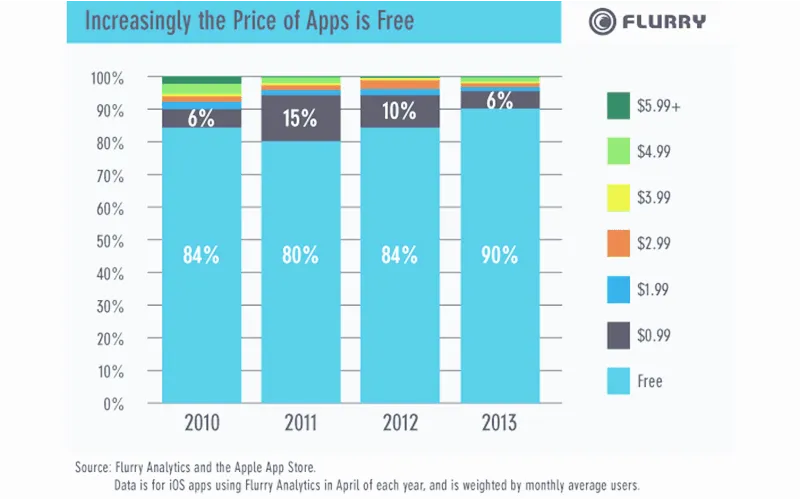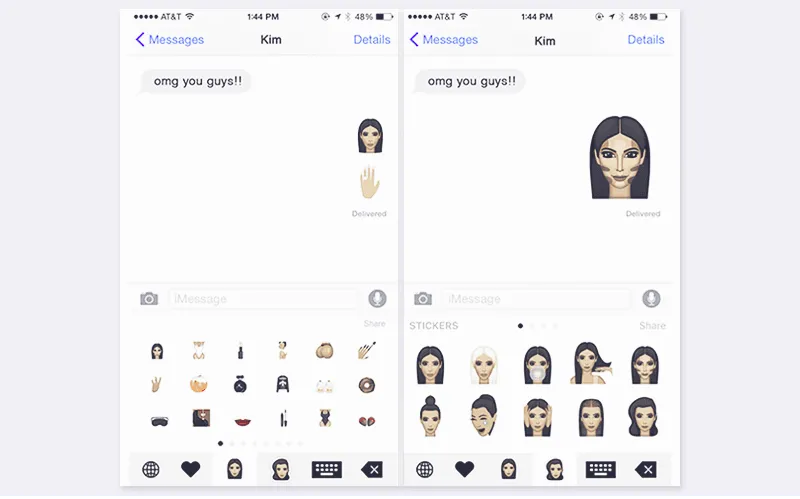How to Monetize Your App, Vol. 1
Updated 03 May 2023
9 Min
5242 Views
People tend to believe that once you've developed an app, you're bound to become enormously rich. Well, yes, there is some truth in it, but in most cases, the enrichment requires a lot of work to be done before knocking at your door. Very few people know that 50% of mobile app developers were below the so-called 'app poverty line' in Q3 2015; only 4% of the venturers got a great success having earned more than $500K+ per app per month. Sorry for the painful truth, but at Cleveroad, we aren't used to telling a white lie to our readers. Instead, we can tell you how to fall into this 4% of lucky ones. Everything you need to know is right below, but before we start, let us ask you a few questions (sure, you don't mind):
- What makes you app so unique? Have you made up with some innovative ideas? Are you going to improve the ones similar applications have?2. Whom are you aimed at? What is your target market?3. What are the invaluable features your users are willing to pay for? Is your app the best at what it does?4. Do you take scalability into consideration? Will your application be able to grow in the nearest future?5. Do you watch competitors' apps for innovations? How do they make money? What do they offer to clients?6. How much are you going to spend on the application development? How much are you ready to spend on it's maintenance?
Do you have answers to these questions? Yes? So let's find out how all of the above is connected to your earnings. Today, we are going to discuss the best mobile app monetization strategies taking into account your app's nature and functionality. At the time you finish reading this article, not only will you know how to make a good profit on your first app, but also you will be able to make informed decisions. Come on!
The main idea
To be honest, defining a monetization strategy is deeply connected to the development process since you need to understand how one or another solution should be implemented in your app. Don't think you will just put a mark on your product and get incredibly rich. That's a wrong position. In fact, everything is completely different. It's necessary to elaborate all possible scenarios. You should always have some escape routes in case one of the approaches used is unsuccessful. There are enough of mobile monetization models that can be easily mixed and matched in the course of the development or after an app is released. However, all of them require a careful consideration. Let's see what they are!
Paid apps
Usually, the idea of making an app paid comes to developers' minds at the very beginning of the monetization lifecycle. Outstanding features, seamless work process, amazing design, and unicity of an app usually motivate a developer to make this decision. So if your future application enjoys all of the aforementioned, you're free to set a price you think will be appropriate for it. The pleasant thing is, you receive the upfront cash every time your app is downloaded, minus the 30% of an app store fee. Although, we'd advise thinking it over because users almost always face mental barrier which adds a lot to the paid applications' down-grade.

However, there is a way for the people who are convinced that their applications are worth paying for them. In this case, we'd recommend lowering a price to $0.99. The most popular price for an app is still ZERO, but setting a 99-cent download fee on an app seems to be the second best option after it. Anyway, it's a kind hard struggle for you to generate an adequate revenue since your application needs a huge number of downloads with this mark.
If you are interested in finding out which applications fall in the category '$2.99+', then go over to this beautiful link to see the most popular paid apps on the Google Play Store. As you can see, most of them are products being sold by vendors who have made their names with much-talked-of desktop games, co-branded apps, web services, and teenage reality shows (in the case of Kimoji). So if we've named one of your lines here, it's quite possible that you will become as rich as Kim Kardashian with your new paid app :)

If there is a rebel soul living inside your heart, you can distribute the app a bit differently. Alternative app stores will serve you right! Amazon App Store, Opera Mobile Store, Samsung Apps Mobile, LG Smart World these all are the potential rivals to Google Play Store. There is a number of alternative Chinese app stores, but, unfortunately, it was impossible to reproduce their names, so you better check them yourself here.
Examples: WhatsApp, Kimoji, Minecraft, Grand Theft Auto: San Andreas.
Freemium
As you might have already guessed, freemium is a combination of 'free' + 'premium'. It's a kind of monetization strategy where a user downloads an app for free but can reveal more of it's abilities by paying for them. These are usually called 'premium accounts'. In other words, users are allowed to take a free version of your product on trial. If they're satisfied with it's quality, they most likely to unlock paid accounts. Take, for example, subscriptions offered in music and video apps. After downloading an app for free, a user is required to pay a fixed price (on a monthly or yearly basis normally) in order to get access to extra features of an app; notice that inaccessibility of these features doesn't make this app inadequate.
Among game developers, there is the strategy called free-to-play. The best example coming to mind is Angry Birds. You download the game for free and enjoy it partly because a number of levels are locked until you pay for them. In short, you can create a minimum viable product (MVP), the initial features of which would be sufficient to work well and attract some clients. Lately, it's possible to upgrade an app and ask users to pay some money in order to wider the app functionality. Visit this page to find out how Google helps Android developers. Apple also is so nice and provides iOS developers with some useful information on subscriptions.
Actually, the freemium app strategy is a great way for your app to be monetized without scaring off the would-be users. Also, this strategy is very close to the next one, so let's have a look at it!
Examples: Spotify, Hulu, Angry Bird, Candy Crash Saga, Puzzle & Dragons, LinkedIn, Trello.
In-app purchases
It goes without saying that you have a strong idea regarding your app's concept long before the development process starts. You know for sure what to build - an online shop or a messenger. In case you intend to build an app implying the selling of goods, you should know that purchases inside your app are broken down into two groups. But what's the difference?
Virtual goods. If you've ever played complex games (strategies mostly), you must have noticed that most of them suggest buying some stuff to accelerate the process. Those, in turn, may be:
- in-app upgrades: to save people's time, they can be offered carrying out a character's upgrade, or unlocking the next level in return for their money.
- in-app consumables: gamers can spend huge money on the new garment, ammunition, and other gizmos to improve their avatar's productivity in a game. All this stuff is available for additional money.
- in-app currency: together with in-app upgrades and consumables, you can propose buying in-app currency for real money; this currency can be spent on the purchasing of an extra time in a game or on some of the above mentioned.
Important! Try not to overuse this technology, though. Doing so can lead to the app's removal from users' devices. All the tactics in your game should be rational. Remember (and now, please excuse the pun), a user buys a joyful toy, not the hole in a pocket.
Mobile games aren't the only example of a product offering the selling of virtual goods. You can market digital fiction, magazines, subscriptions, photos, additional services specific for your app type, and so forth.
The virtual goods selling implies a complete cooperation with a distribution platform chosen (be it Google Play Store or Apple App Store). No third parties shall be involved! Luckily for you, they provide an-easy-to-integrate SDKs for such purposes. Follow this link if you're an Android developer or this one if you develop for iOS.
Physical goods. Here we mean the realization of real goods. Anything you can imagine can be sold by means of your app (if it's an online shop, of course), from clothes to ticket reservations. There is only one little thing remains to be done payment gateway integration. Buying products on your app, users should know that their payment data are safe. In the case of the physical goods, you can involve any payment gateway provider you want. However, we advise making your choice in favour of the most reliable one to deliver seamless and secure transactions.
Examples: Asos, Hotel Tonight, Plants vs. Zombies, Family Guy: The Quest for Stuff, The Simpsons: Tapped Out, and any other game suggesting buying of some goods either virtual or physical.
Selling of APIs and source code
Here we're overviewing some alternative ways of mobile app monetization. Now you'll find out why we've called them 'alternative'.
Sell your APIs. Let's imagine that you've done a lot of work to create a powerful application solving different problems and, for sure, using some innovative ideas. You or your developers have come up with a great program solution and it has no parallel on the market. The great idea is to make your APIs free-to-use, but making it paid is even greater. Think about it and place it on your official website if something.
Sell your app off. In case you're going to focus on your next, maybe, bigger and heavier application and the maintenance of your 'older' product is no longer in your interest, you may sell it's IP and code on a service like Apptopia. As a result, you have money in your pocket, and your work has not been in vain.
For developers (mostly). If you've created something really amazing, you don't want to get through all these monetization stages and other stuff, then you need a platform to get your reward. In this case, you don't sell your app's IP but you publish it's source code in order that other developers can take it, make some corrections if needed and do what you've receded from (think monetization strategies :)).
Ok, it seems that we've come to an end. What?! Are you suspecting us of concealing some information? Well, we give up, you caught us. As we already said, you're free to mix and match strategies. Of course, there are more of them. So to see the following part of this awesome read covering other monetization formats, go over to this link.
P.S. Don't forget to subscribe ;)

Evgeniy Altynpara is a CTO and member of the Forbes Councils’ community of tech professionals. He is an expert in software development and technological entrepreneurship and has 10+years of experience in digital transformation consulting in Healthcare, FinTech, Supply Chain and Logistics
Give us your impressions about this article
Give us your impressions about this article
Comments
1 commentsTHIS IS COOL INFORMATION